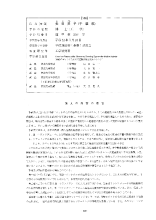Direction Measurable Ultrasonic Sensing Systems for Mobile Robots 移動ロボットのための方位計測超音波センシング
Access this Article
Search this Article
Author
Bibliographic Information
- Title
-
Direction Measurable Ultrasonic Sensing Systems for Mobile Robots
- Other Title
-
移動ロボットのための方位計測超音波センシング
- Author
-
矢田, 晃子
- Author(Another name)
-
ヤタ, テルコ
- University
-
筑波大学
- Types of degree
-
博士 (工学)
- Grant ID
-
甲第2364号
- Degree year
-
2000-03-24
Note and Description
博士論文
資料形態 : テキストデータ プレーンテキスト
コレクション : 国立国会図書館デジタルコレクション > デジタル化資料 > 博士論文
It is becoming reality that robots act in our living life environment in recent years. Not only in special environment as like factory but also in our daily living office buildings, robots are working without disturbing us. It is important for robot to know environment around itself, in order to move around us safely especially at such conditions. Ultrasonic sensor is one of the most popular external sensor among various external sensors for mobile robots. A pulse-echo method which transmit a pulse and measure deistance using time-of-flight is often used for mobile robot ultrasonic sensor. However, it is difficult to measure accurate bearing angle because of its wide beam width. On the other hand, the reflecting objects in indoor environment can be considered as specular in regard to an ultrasonic wave length in the air. When ultrasound reflect specularly, an area corresponding to a leading edge of an echo is assumed as a point. Consequently, if it is possible to improve bearing measurement accuracy, the ultrasonic sensor can measure the reflecting point. The reflecting point shows special feature of the environment, for example position of corner or bearing angle of wall, which are quantitative information. It is very useful for environment recognition of mobile robots to detect those reflecting points which show such information accurately. In a word, it is really important to develop accurate direction measurable ultrasonic sensor for mobile tobots. Moreover, simplicity and real-time operation are also important to use it for moving mobile robots. Purpose of this reaserch is the development of highly efficient ultrasonic sensors for indoor mobile robots environment recognition. Especially, it emphasized to improve a weak point of ultrasonic sensor, bad bearing accuracy, without injuring merit, fast measurement speed. For this purpose, fast and accurate reflecting points measurement method are proposed, and their usefulness are confirmed by actual proofs on mobile robots in this research. ・・・
1999
Japanese title from p. ii
Bibliography: p. 127-131
Table of Contents
- Abstract
- Contents
- I Introduction
- 1 Introduction
- 1.1 Mobile robots and sensors
- 1.2 Ultrasonic sensing
- 1.3 Indoor environment
- 1.4 Requirements for mobile robots ultrasonic sensors
- 1.5 Purpose of this research
- 1.6 Results of this research
- 1.7 Thesis outline
- II Bearing measurement by a single transducer
- 2 Introduction to bearing measurement by a transducer
- 2.1 Theoretical back-ground
- 2.2 Main idea
- 2.3 Overview of Part II
- 3 Proposal of bearing measurement using frequency
- 3.1 Bearing measurement by frequency difference
- 3.2 Measuring method
- 3.3 Summary
- 4 Experiments on bearing measurement by a transducer
- 4.1 Frequency characteristics
- 4.2 Evaluations
- 4.3 Application to the mobile robot
- 4.4 Discussion on the experiment
- 5 Conclusion to bearing measurement by a transducer
- 5.1 Discussion
- 5.2 Conclusion
- III Direction measurable sonar-ring
- 6 Introduction to direction measurable sonar-ring
- 6.1 Background
- 6.2 New sonar-ring
- 6.3 Overview of part III
- 7 Fast and accurate direction measurable sonar-ring
- 7.1 Basic ideas
- 7.2 Difference from previous methods
- 7.3 Summary
- 8 Direction measurable sonar-ring system design
- 8.1 System architecture
- 8.2 Hardware
- 8.3 Software
- 8.4 Summary
- 9 Experiments of direction measurable sonar-ring
- 9.1 Evaluation experiments
- 9.2 Environment recognizing experiments
- 9.3 Conclusive discussion on the experiments
- 10 Conclusion to direction measurable sonar-ring
- 10.1 Discussion
- 10.2 Conclusion
- IV Conclusion
- 11 Conclusion
- 11.1 Discussion
- 11.2 Conclusion
- Bibliography

